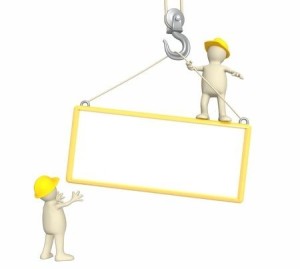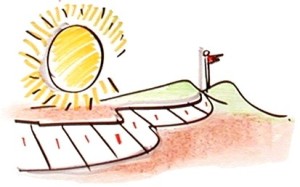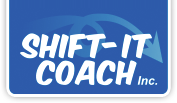Audio Version: Click Player to Stream or Right Click on Link to Download. For full Audio Library of Past Messages, Click Here
I’ve been using visual techniques with coaching and personal growth since the mid-1990s. And now more and more of my process colleagues are waking up to the power of using these methods with their own clientele.
 One gal in my current SHIFT-IT Online program, who works for the federal government in her country and is also a coach, called the visual approach her ‘secret sauce’.
One gal in my current SHIFT-IT Online program, who works for the federal government in her country and is also a coach, called the visual approach her ‘secret sauce’.
I agree with her, although it’s not so secret anymore!
Good Process Design Is Key:
Before I share thoughts about why working visually with individuals works, I first need to give a shout out to ‘good process design’. The reason this method works is not just because of visuals per se, it’s because of visuals being properly integrated into an effective, underlying process. Whether you are doing just one exercise with your client or that exercise is embedded in a larger flow.
 To be blunt about it, if your process underneath sucks (i.e. you aren’t clear about what you are doing with your client, why, and where it is heading) then using attractive visuals isn’t going to help you. In fact, using visuals with a poorly designed process can just make your lack of design more apparent.
To be blunt about it, if your process underneath sucks (i.e. you aren’t clear about what you are doing with your client, why, and where it is heading) then using attractive visuals isn’t going to help you. In fact, using visuals with a poorly designed process can just make your lack of design more apparent.
In my visual skills courses, I’m constantly driving home that process must come first … then you use visuals (and other methods) in service of your process intentions.
 In my own coaching practice, I developed my SHIFT-IT Visual Coaching System®, an integrated process with 14 main moves … each of these moves is built into a visual map. Yes, it’s attractive and visual, but even, more importantly, it’s a solid, proven process underneath it all. It has ‘process legs’. Good visual process work is not just pretty icing on the top, it’s about solid structure throughout.
In my own coaching practice, I developed my SHIFT-IT Visual Coaching System®, an integrated process with 14 main moves … each of these moves is built into a visual map. Yes, it’s attractive and visual, but even, more importantly, it’s a solid, proven process underneath it all. It has ‘process legs’. Good visual process work is not just pretty icing on the top, it’s about solid structure throughout.
Large Portion of Population Are Visual Thinkers:
 Now that we are clear that working visually needs to be tied to good process, we can now discuss the visual aspect of things. Cognitive researchers have done all sorts of studies on how people best learn. And these studies consistently show that a large percentage of people favor their visual sense (over auditory and kinesthetic).
Now that we are clear that working visually needs to be tied to good process, we can now discuss the visual aspect of things. Cognitive researchers have done all sorts of studies on how people best learn. And these studies consistently show that a large percentage of people favor their visual sense (over auditory and kinesthetic).
So it only makes sense to work in a medium that most people naturally like and need.
Surprisingly most coaching and personal growth experiences do not use visual methods. Therefore, there is a huge opportunity to integrate visuals effectively into all sorts of process work with individuals, partners and couples.
Auditory and Kinesthetic Types Also Benefit:
What I like about working visually is that it does not omit the other learning styles – the auditory and the kinesthetic. There is still plenty of speaking and hearing and I have learned over the years the power of getting clients involved in the actual building of their visual displays too, to accommodate the kinesthetic learners.
 An ironic factoid … even though I am well known for working visually I am actually a kinesthetic processor. I need to get tactile and do things in order to learn. Which makes sense, because as a Visual Facilitator and Coach I’m creating the displays with and for my clients.
An ironic factoid … even though I am well known for working visually I am actually a kinesthetic processor. I need to get tactile and do things in order to learn. Which makes sense, because as a Visual Facilitator and Coach I’m creating the displays with and for my clients.
Which probably is a big part of the reason why I have stuck with these methods for over two decades now.
Knowing how much I benefit from the actual creation of the displays I like to get my clients creating them too. All of my visual maps come with do-it-yourself directions and I often assign certain maps for breakouts or for homework.
Memory, Commitment and Communication Aid:
Unlike most other coaching and personal growth work, with Visual Coaching, there is a record created of the steps, insights and aha’s of the coaching session. The visual notes act as wonderful memory devices that client and coach use to remember sessions and commitments.
 These notes also are very handy for when a client decides to communicate with others about the thinking and feeling they uncovered in a coaching session.
These notes also are very handy for when a client decides to communicate with others about the thinking and feeling they uncovered in a coaching session.
I’ve had clients choose to share their session notes and maps with spouses, family, friends, colleagues, counselors, financial advisors, even realtors.
Recent Technology Is Adding More Range to Visual Coaching:
 Back when I initially started experimenting with Visual Coaching I was limited in the interactivity I could get by the physical proximity of my clients.
Back when I initially started experimenting with Visual Coaching I was limited in the interactivity I could get by the physical proximity of my clients.
For years, the only way to get true interactivity was to have them physically sitting right in front of me and the large sheets of paper we were working on.
However, now with advances in web conference and digital tablets it is relatively easy to digitally mimic the paper effect, no matter where the client is physically based.
This is a HUGE breakthrough in this methodology and one that is bursting this method wide open for other coaches, therapists, counselors and the like. I’m already seeing growing numbers of participants in my Visual Coach Certification dive right into the new digital methods. Which allows them to work with their clients with geography no longer being an inhibiting factor.
The Future Is Bright:
It’s already been an amazing experience being part of the visual revolution that has happened with the spread of Graphic Recording and Graphic Facilitation methods across the globe in the last two decades.
 As Visual Coaching holds such a special place in my heart, I’m sensing even greater momentum in this special niche within the niche happening now too. Which is awesome as these methods when done properly are very effective and will play a wonderful part in SHIFTing our world for the better!
As Visual Coaching holds such a special place in my heart, I’m sensing even greater momentum in this special niche within the niche happening now too. Which is awesome as these methods when done properly are very effective and will play a wonderful part in SHIFTing our world for the better!



